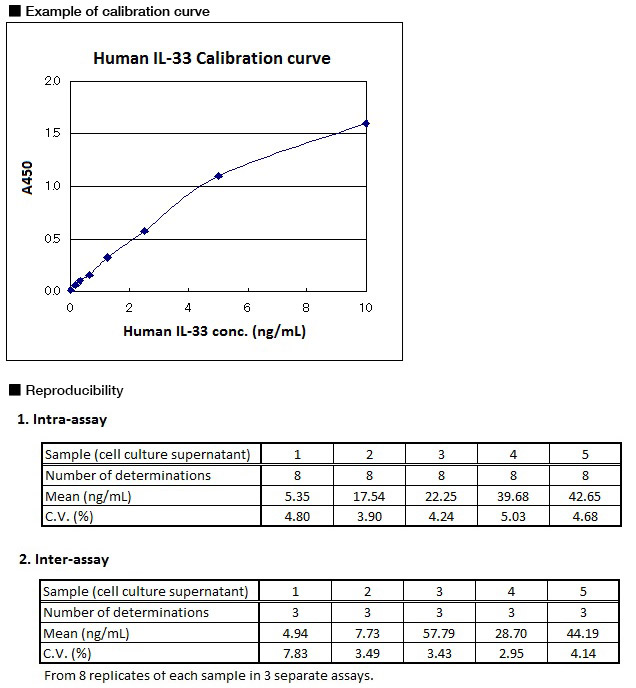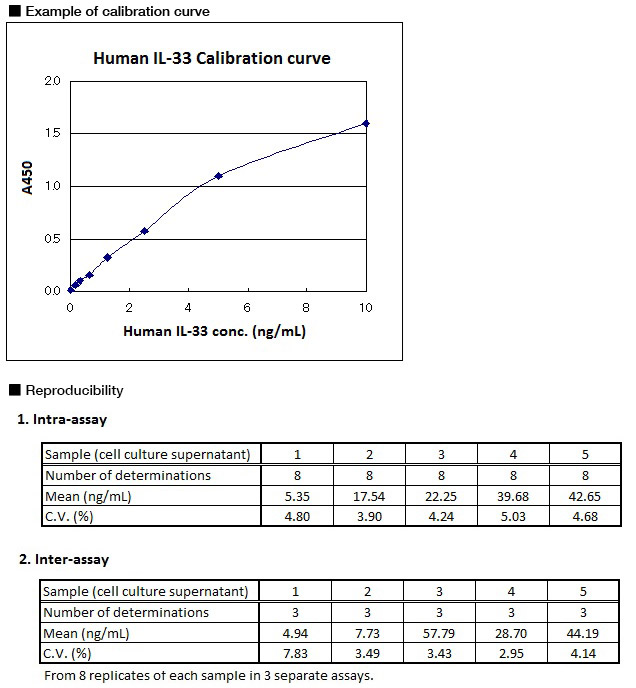Human IL-33 Cytokine domain Detection Kit
| Code | Size | Price |
|---|
| MBL-7650 | 96 Wells | £1,155.00 |
Quantity:
Prices exclude any Taxes / VAT
Overview
Host Type: Human
Regulatory Status: RUO
Application: Enzyme-Linked Immunosorbent Assay (ELISA)
Shipping:
4°C
Storage:
4°C
Images
Documents
Further Information
Background:
Interleukin-1 (IL-1) family, such as IL-1α/β and IL-18, has important functions in host defense, autoimmune disease and inflammation.
IL-33, a member of the IL-1 family of cytokine, is a ligand for the IL-1 receptor families ST2 (IL-33Rα chain) and IL-1RAcP, which induces the production of Th2-associated cytokines from mast cells and basophils. IL-33/ST2 signaling results in activation of NF-κB or AP-1 induces Th2 associated cytokines, IL-4, IL-5 and IL-13.
IL-33 is also described as a Nuclear Factor from High Endothelial Venules (NF-HEV) and as DVS27. IL-33 is localized in the nucleus of human endothelial and epithelial cells that binds to chromatin via a homeodomain and nuclear localization signal in its N-terminus.
IL-33 is a dual functional protein that may function as both a proinflammatory cytokine and a nuclear factor with transcriptional regulatory properties.
Recent many studies reported that IL-33 is expressed in various organs and cells. Furthermore, IL-33 has been linked to many diseases, including rheumatoid arthritis, atopic dermatitis, asthma, pollinosis, atherosclerosis, cardiovascular diseases and autoimmune diseases.
?Human IL-33 Cytokine domain Detection Kit? is a reagent for measuring human IL-33 specifically with ELISA, not for measuring mouse IL-33.
Description:
The Human IL-33 Cytokine domain Detection kit measures human IL-33 by sandwich ELISA. The assay uses polyclonal antibody and monoclonal antibody against two different epitopes of human IL-33.
In the wells coated with anti-human IL-33 polyclonal antibody, samples to be measured or standards are incubated. After washing, the biotinylated anti-human IL-33 monoclonal antibody is added into the microwells and incubated. After another washing,
the streptavidin-HRP is added and incubated. Following a final washing, the peroxidase substrate is mixed with the chromogen and allowed to incubate for an additional period of time.
An acid solution is then added to each well to terminate the enzyme reaction and to stabilize the developed color. The optical density (O.D.) of each well is then measured at 450 nm using a microplate reader. The concentration of human IL-33 is calibrated from a dose response curve based on reference standards.
Kit Components:
Microwell strips, Human IL-33 (Cytokine domain) Standard, Anti-Human IL-33-Biotin, Streptavidin-HRP, Conjugate Diluent, Assay Diluent, Wash Concentrate, Substrate Reagent, Stop solution
Sensitivity:
0.2 ng/mL
Shelf Life:
1 year
Target:
IL-33
References
Baekkevold ES et al. Molecular characterization of NF-HEV, a nuclear factor preferentially expressed in human high endothelial venules. Am J Pathol.163, 69-79 (2003) (PMID:12819012)
Schmitz J et al. IL-33, an interleukin-1-like cytokine that signals via the IL-1 receptor-related protein ST2 and induces T helper type 2-associated cytokines. Immunity 23, 479-90 (2005) (PMID:16286016)
Carriere V et al. IL-33, the IL-1-like cytokine ligand for ST2 receptor, is a chromatin-associated nuclear factor in vivo. PNAS. 104, 282-7 (2007) (PMID:17185418)
Roussel L et al. Molecular mimicry between IL-33 and KSHV for attachment to chromatin through the H2A-H2B acidic pocket. EMBO Rep. 9, 1006-12 (2008) (PMID:18688256)
Cayrol C and Girard JP. The IL-1-like cytokine IL-33 is inactivated after maturation by caspase-1. PNAS. 106, 9021-6 (2009) (PMID:19439663)
Luthu AU et al. Suppression of interleukin-33 bioactivity through proteolysis by apoptotic caspases. Immunity 31, 84-98 (2009) (PMID:19559631)
Smith DE. IL-33: a tissue derived cytokine pathway involved in allerigic inflammation and asthma. Clin Exp Allergy 40, 200-8 (2010) (PMID:19906013)
Matsuyama Y et al. Increased levels of interleukin 33 in sera and synovial fluid from patients with active rheumatoid arthritis. J Rheumatol. 37, 18-25 (2010) (PMID:19918048)
Liu X et al. Structural insights into the interaction of IL-33 with its receptors. PNAS. 110, 14918-23 (2013) (PMID:23980170)




